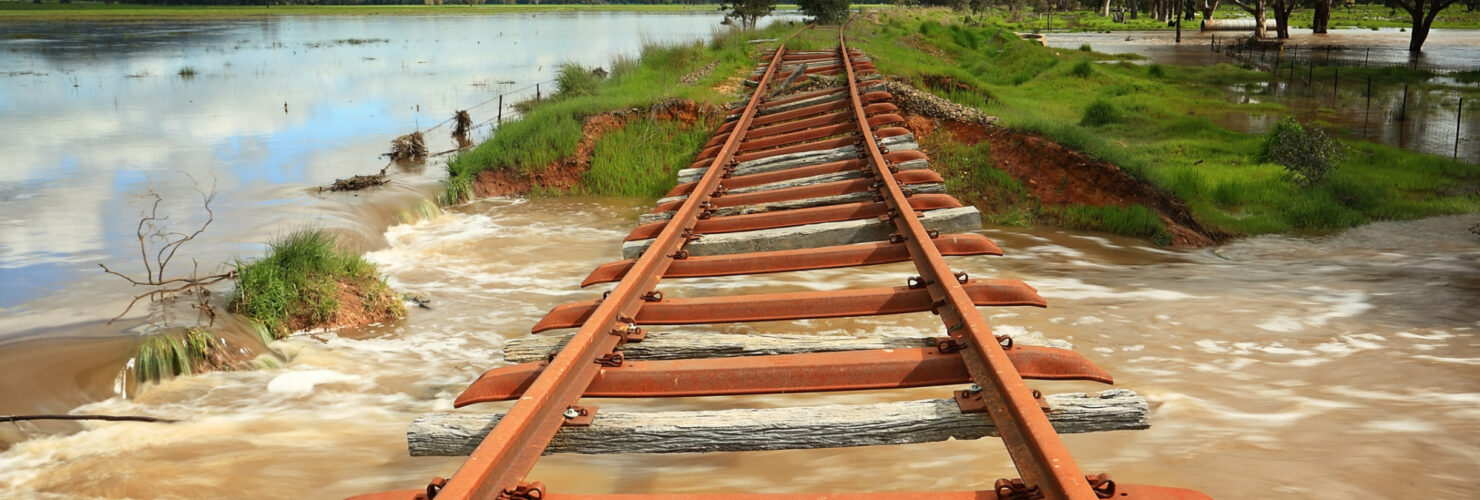Wednesday, March 26, 2025
Safety Message: Track Obstructions
Failing to put in place controls to adequately protect the railway from track obstructions can result in serious incidents such as collisions and derailments.

Track obstructions related to rail infrastructure include objects left or placed on the track, landslides, rock falls, fallen trees, flood water or other infrastructure obstructions. Track obstructions that relate to rolling stock include:
- wagons stored within fouling points causing side swiping collisions– see Safety Message: Train to train collisions - risks, causes & controls
- runaways and train partings causing rolling stock to be left on track causing head-head or head-to-rear collisions – see Safety Message: Runaways within and from yards and sidings and Safety-Alert-RSN-2010-01-Train-parting-occurrence-driver-alert-systems-WA-DoT-Rolling-stock-Risk-management-2010.pdf; and
- unsecure loading of wagons resulting in freight falling on to the track or derailment of wagons that have not been properly secured – see Secure your load | ATSB and Freight train’s dislodged steel jumbo coil highlights the risks of track obstructions | ATSB.
In this safety message we focus on track obstructions that relate to rail infrastructure, and the rail infrastructure managers (RIMs) who are responsible. So, this message covers both the causes and contributing factors for rail infrastructure-related track obstructions, as well as controls designed to mitigate the risk.
Causes and contributing factors
1. Organisational factors
- Inadequate policies, processes, procedures and practices for managing track obstructions
- Inadequate risk controls, such as not adopting the hierarchy of controls, or adopting administrative controls rather than more effective engineering or elimination controls
- Poor maintenance practices, such as inadequate management of culverts or vegetation
- Inadequate training, supervision, monitoring and oversight
2. Technological or equipment factors
- Infrastructure collapse, such as bridge or structure collapse
- Geotechnical collapse, such as embankment slips and rockfalls
- Parts of overhead structures falling onto the track due to component degradation or failure
3. Environmental factors
- Extreme weather events, such as strong winds and/or flooding
- Prolonged wet weather events
- Earthquakes
4. People-related factors
- Miscommunication or not following procedures
- Objects placed on the track or thrown from a structure through vandalism
- Objects mistakenly left on track such as before or after track work or an occupation
- Unauthorised vehicles entering the corridor
Controls
Given the range of operational environments within the Australian rail industry, the following controls should be noted. While this is not an exhaustive list, rail transport operators (RTOs) must consider various factors, including the likelihood of the hazard and the degree of harm to determine what controls are reasonably practicable to implement (see the ONRSR Guideline – Meaning of duty to ensure safety so far as is reasonably practicable SFAIRP for more information).
Substitution
- Install larger culverts where previous ones were inadequate.
- Replace vegetation with more robust species that can withstand greater wind or soil saturated conditions.
Engineering
- Prune or clear vegetation to reduce the risk of it falling on the track and causing an obstruction.
- Install barriers and/or fencing along rail corridors to prevent vehicles and/or other objects entering the railway corridor.
- Follow design and construction management processes and procedures to reduce the risk of structures falling onto the track. Such structures include, but are not limited to, footbridges, bridges, water tanks, radio masts, telephone towers, overhead electrical structures, advertising signage and billboards.
- Follow construction, maintenance and safeworking procedures to reduce the risk of objects falling during the construction and/or installation of any of the above structures.
- Perform routine inspections and monitoring of structures and other objects and assets within and adjacent to the railway corridor (such as inspection and monitoring of trees, cuttings, etc) to ensure they remain clear of the track, including during periods of inclement weather.
- Install rolling stock mounted sensing and detection equipment to detect obstacles on the track. Newer systems are incorporating machine learning.
- Design, construct or upgrade rolling stock to appropriate collision protection standards such as EN 15227 Railway Applications - Crashworthiness requirements for rail vehicles.
- Conduct flood impact assessments to identify and mitigate flood prone areas through hydraulic improvements (such as installing a larger culvert) and install flood monitoring at high-risk locations.
- Conduct engineering assessments of cuttings and other geotechnical features and install mitigation and advanced warning systems at high-risk locations.
Administrative
- Establish efficient systems to quickly communicate hazard information identified by the public or other sources to network control.
- Develop systems, protocols and procedures for efficient communications between network control and the train driver, especially under emergency conditions – see ONRSR safety message on emergency management plans.
- Implement methods and procedures for train drivers to accurately identify the location and reporting of an obstruction.
- Provide training to all relevant Rail Safety Workers.
- Develop and enforce Interface Agreements (where applicable) to ensure that all parties manage the risks of obstructions falling on to the track.
Key documents and actions
Operators are encouraged to review their Safety Management System to ensure the controls listed in this safety message are considered. Guidance material that can assist when reviewing systems and procedures include:
- Safety message - Emergency Management Plans
- Safety Message - Altered, message, working, safety, arrangements
- Safety Message - Managing your bridge assets
- Safety Message - Managing your track infrastructure assets
- Safety Message - Management of Change
- Safety Message - Level Crossings and the Importance of Ongoing Risk Assessment
- ATSB - Secure your load
- ATSB - Freight train’s dislodged steel jumbo coil highlights the risks of track obstructions | ATSB.
- Safety Message: Runaways within and from yards and sidings
- Safety-Alert-RSN-2010-01-Train-parting-occurrence-driver-alert-systems-WA-DoT-Rolling-stock-Risk-management-2010.pdf
- Safety Message: Train to train collisions - risks, causes & controls